Learn expert techniques for growing eggplant from seed. Grow, care, and harvest eggplant the right way and you’ll get a big harvest of this amazing purple vegetable!
Eggplant is a member of the nightshade family and is closely related to potatoes and tomatoes. It is most commonly recognized as a large blackish-purple vegetable known for it’s use in dishes such as Eggplant Parmigiana, but a short browse through any seed catalog will reveal eggplant in all shapes, sizes and colors.
This site contains affiliate links. If you make a purchase using one of these links, I may earn a commission. Please see my disclosure page for more information about cookies collected and our privacy policy.
And while it is a beautiful and versatile vegetable, growing eggplant isn’t quite as easy as growing other nightshades. But with a few tips you can learn how to grow your own eggplant in the garden!
Want to learn how to grow more? Check out my guides to the 11 easiest crops for new gardeners!
How to Grow Eggplant from Seed In Your Garden
Getting a Head Start Growing Eggplant
To get a head start on your eggplant it is best to start them from seed about 6-9 weeks before your last frost date. They are a warm weather crop and require a soil temperature of about 80 degrees F to germinate properly.
The use of a heating pad, or keeping them in the warmest room of your home, will greatly increase your germination rates. Plant your seeds about 1/4 in. deep in your choice of seed starting medium. It should take between 1 and 2 weeks for your eggplant seeds to germinate.
You may notice that your eggplant seedlings are growing much slower than their relative, tomatoes, and that is because eggplant prefer warmer growing conditions. As it gets closer to spring you should notice their growth rate increase.
Once your seedlings reach about 3 inches tall, transplant them into larger containers. You will not want to transplant your eggplant plants into the garden until the weather has warmed and the daytime temperatures are in the 70s.
You can, however, harden them off outside in later spring before planting them into the ground. Here’s more on how to harden off your seedlings (and why you shouldn’t skip it!)
My Yearly Gardening Planner is perfect for keeping track of everything- from your seed inventory to planting dates to disease and pest problems. Start planning your best garden today!
Planting Your Eggplant Outside
Whether you buy your plants from a nursery or start your own, you do not want to plant out your eggplant until the soil and air temperatures have sufficiently warmed.
Raised beds and plastic mulch can be used to help warm the soil a little earlier in the season.
Here are some tips on getting your eggplant off to a good start:
- Choose your location wisely. Growing eggplant needs full sun and well-drained soil.
- Give them room to grow by placing at least 2-3 ft between each plant.
- Eggplant does not like standing water, but do need to be watered deeply weekly.
- Add mulch to help keep the soil cool and conserve water.
To transplant your eggplant seedlings outside, dig a hole that is a little wider and deeper than the root ball of your seedling.
I like to dig compost directly into the planting hole- I usually use mushroom compost. Add a trowel-full of compost and mix it up, then place the eggplant plant in. Make sure the planting depth in the ground is the same as the planting depth in the containers.
Fill the hole and pack down the soil so there are no air pockets and water thoroughly.
Plant your transplants about 2-3 feet apart in all directions. They can get quite bushy- so make sure to give them enough room! This will keep them healthier too.
Troubleshooting Problems While Growing Eggplant
Flea Beetles are by far the worst pest for eggplant. They can destroy and kill a small plant in a matter of days if you aren’t careful.
Starting with larger, healthy plants can go a long way on combating these bugs, but even then they may still struggle.
I keep a good dusting of Food Grade Diatomaceous Earth on all of my eggplant for the first few weeks- reapplying after rain or watering. This is very effective in killing the flea beetles until your eggplant has grown large enough and strong enough to fend for itself.
Other problems pests are the Colorado Potato Beetle and the Tomato Hornworm, both of which can be effectively hand-picked with out much trouble. Check out How to Get Rid of These 8 Garden Pests for more information on getting rid of pests in the organic garden.
Companion planting with beans, herbs, and calendula can also help with these pests. You can learn more about companion planting here: Best Companion Plants for Eggplant in Your Garden
Eggplant is also susceptible to verticillium wilt. Using proper clean gardening techniques and crop rotation can help in prevention.
Eggplant can also do well in a large container- such as a 5-gallon bucket, if wilt is particularly bad in your garden.
Make your homestead dreams come true! The Homestead Goal Planner will help you prioritize your life and your homestead goals and keep you on track with good planning practices. After all, goal with out a plan is just a dream!
Harvesting and Using Your Eggplant
If you’ve never grown eggplant before, you may be wondering how to tell if your eggplant is ready for harvest.
Eggplant should be picked when it is still on the small size, when the skin takes on a high shine. Like zucchini, you want to pick eggplant when they are immature. This lends to a better flavor and smoother flesh.
Picking often will also encourage more growth and a more abundant harvest for you. When you cut open an eggplant, it should have a soft inside with very small, soft seeds.
If the inside is on the tougher side or the seeds have begun to harden, your eggplant is past it’s prime and will have a more bitter taste.
To harvest, you’ll need a sharp knife or a pair of scissors to cut through the tough stems. Many eggplant plants are spiny and will hurt if you grab and try to pull them off!
It’s almost impossible to break the eggplant off the plant with just your hands- so a cutting utensil is a must!
Eggplant can be stored short term at 50-54F, but always try to use or preserve it right away. If you are lacking in recipe inspiration, here are more than 50 Eggplant Recipes to Try!
More about Using and Preserving Your Eggplant:
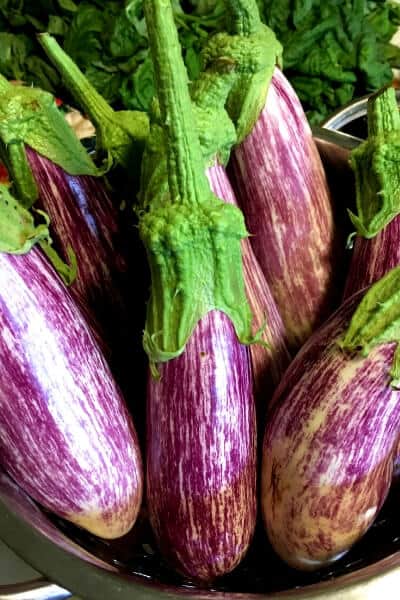
Listada De Gandia Eggplant harvest
Varieties of Eggplant to Try
Ping Tung: This is a long, thin eggplant that comes out of Taiwan. The plants are extremely prolific and the fruits are tender, mild and sweet. This is one of my favorites to grow!
Purple Long: Coming from Italy, this eggplant has a more delicate flavor. It’s flesh is tender without a lot of seeds.
Rosita: These eggplant are a lovely bright purple color. The flesh is white and mild and the skin is very tender.
Black Beauty: This is your standard black, egg shaped eggplant. It requires a little longer of a season than some and isn’t as productive, but it is a good standby in your garden.
Listada De Gandia: This is one of my favorite eggplant varieties (pictured above). It’s a beautiful, full eggplant with purple and white striping. Tender flesh and great flavor.
Related Reading: Top 7 Eggplant Varieties to Grow
FAQ for Growing Eggplant:
How long does it take for eggplant to grow?
If you are starting your eggplant from seed you can expect to harvest in 100-150 days depending on the variety you are growing.
It’s a little quicker if you are growing from transplants, taking about 70-85 days from planting in the ground to harvest.
When is eggplant ready to pick?
After it’s been the right amount of time, how do you know when eggplant is ripe and ready? A ripe eggplant will be glossy, firm, and uniformly colored.
If you are unsure if your eggplant is ripe or not, cut one and off the plant and cut it open:
- No seeds at all? Under-ripe.
- Large dark seeds? Overripe.
- Tiny, soft seeds? Just right.
- Pithy skin? Overripe.
It’s always best to harvest slightly immature fruits than overripe.
What do eggplant seedlings look like?
Eggplant seedlings don’t look the same as other night shades like tomatoes or peppers, and if you know what you are looking for they are easy to identify.
Eggplant seedlings have more round leaves when it comes to their first true leaves. Here’s a picture of eggplant seedlings, both just after sprouting and just before transplanting:
Is eggplant a fruit?
Well- that depends on who you ask.
Scientifically and botanically speaking, the eggplant is a fruit. It meets the technical definition of fruit which is the [edible] reproductive body of a plant containing the seeds.
When it comes to the kitchen, most people consider eggplant a vegetable though.
Want to learn more about the distinction? Check out these articles: Is a cucumber a fruit? or Is a tomato a fruit (if you want to read about the legal definition as well!)
Beginning gardener? Check out these articles:
11 Tips for a Successful First Garden
The Ultimate Guide to Companion Planting
How to Grow Vertically in the Garden

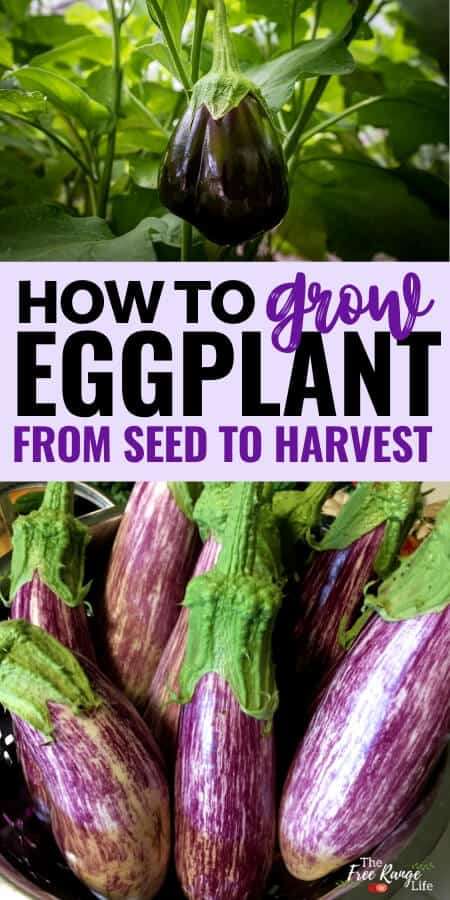
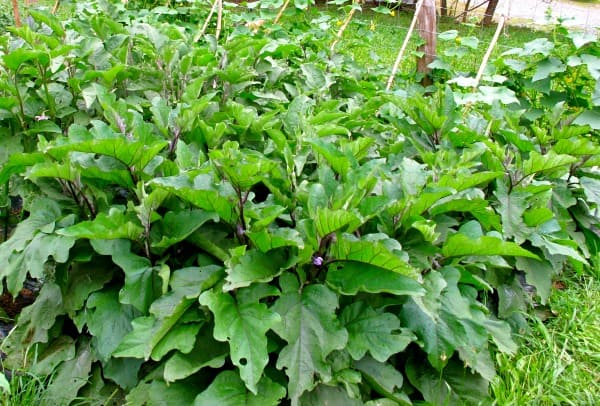
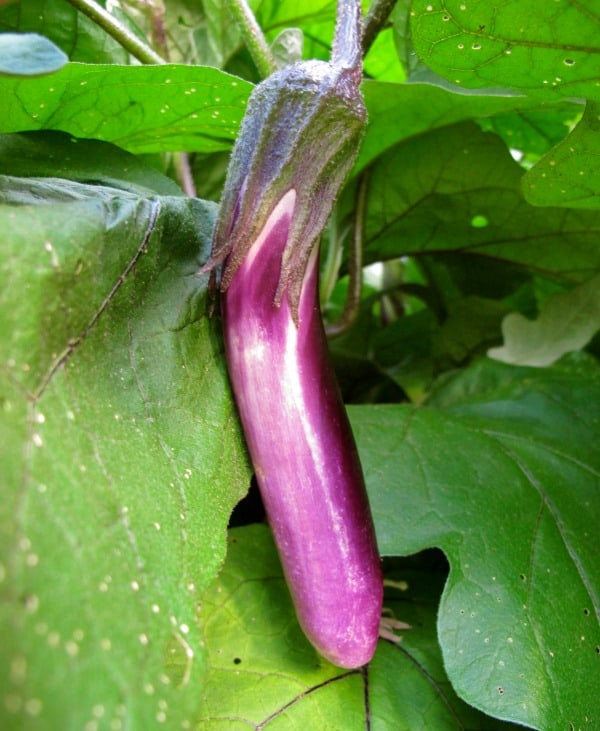
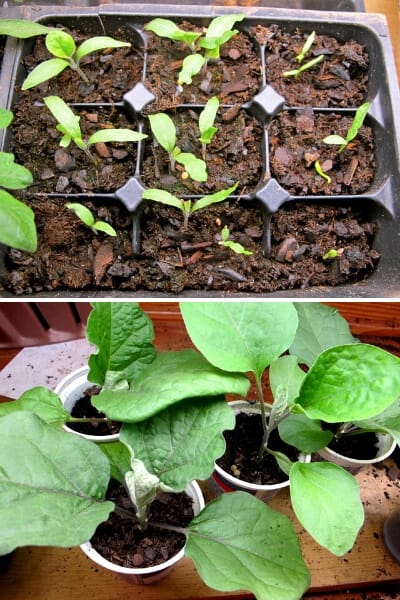


I’ve never tried growing eggplant before! Thanks for the info. Pinning for later :)
Great info! Even here up north, I have grown eggplants in the greenhouse. Not always successful, but it still is fun.
Isn’t eggplant just so gorgeous?! Thanks for sharing at Green Thumb Thursday and we hope to see you tomorrow!
This is my first year of having two small raised beds for gardening. As a child, I came from a family of Italian immigrants that basically survived on their crops. A pity I didn’t pay attention to gardening as a child.
Good to know. I am trying a white variety this year also. Fingers crossed, it will do well.
How and can I produce seeds from this years fruit, so I’ll have seeds for next years planting?
I haven’t tried growing eggplants before but it’s good to know that it’s a bit easier than I thought at first. Thank you for the great information about eggplant!